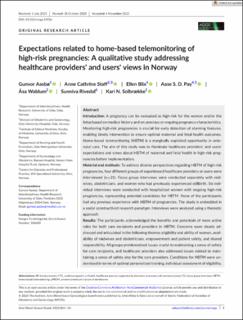Expectations related to home-based telemonitoring of high-risk pregnancies: A qualitative study addressing healthcare providers' and users' views in Norway
Aasbø, Gunvor; Staff, Anne Cathrine; Blix, Ellen; Pay, Aase Serine Devold; Waldum, Åsa; Rivedal, Sunniva; Solbrække, Kari Nyheim
Peer reviewed, Journal article
Published version
Permanent lenke
https://hdl.handle.net/11250/3104217Utgivelsesdato
2023Metadata
Vis full innførselSamlinger
Originalversjon
https://doi.org/10.1111/aogs.14726Sammendrag
Introduction: A pregnancy can be evaluated as high-risk for the woman and/or the fetus based on medical history and on previous or ongoing pregnancy characteristics. Monitoring high-risk pregnancies is crucial for early detection of alarming features, enabling timely intervention to ensure optimal maternal and fetal health outcomes. Home-based telemonitoring (HBTM) is a marginally exploited opportunity in ante-natal care. The aim of this study was to illuminate healthcare providers' and users' expectations and views about HBTM of maternal and fetal health in high-risk preg-nancies before implementation.Material and methods: To address diverse perspectives regarding HBTM of high-risk pregnancies, four different groups of experienced healthcare providers or users were interviewed (n= 21). Focus group interviews were conducted separately with mid-wives, obstetricians, and women who had previously experienced stillbirth. Six indi-vidual interviews were conducted with hospitalized women with ongoing high-risk pregnancies, representing potential candidates for HBTM. None of the participants had any previous experience with HBTM of pregnancies. The study is embedded in a social constructivist research paradigm. Interviews were analyzed using a thematic approach.Results: The participants acknowledged the benefits and potentials of more active roles for both care recipients and providers in HBTM. Concerns were clearly ad-dressed and articulated in the following themes: eligibility and ability of women, avail-ability of midwives and obstetricians, empowerment and patient safety, and shared responsibility. All groups problematized issues crucial to maintaining a sense of safety for care recipients, and healthcare providers also addressed issues related to main-taining a sense of safety also for the care providers. Conditions for HBTM were un-derstood in terms of optimal personalized training, individual assessment of eligibility.

